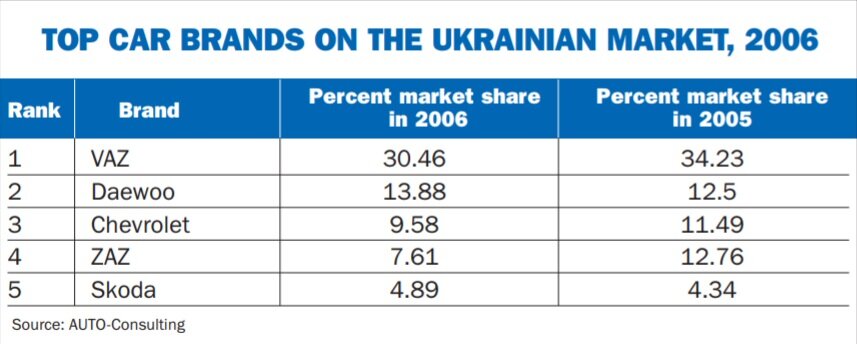Ukrainians are increasingly choosing foreign middle-class car brands.
With personal incomes gradually rising, more middle-class Ukrainians are investing their earnings in the purchase of a new car, fuelling a 40 percent year-on-year rise in new car sales in 2006.
What’s more, Ukrainians are increasingly choosing foreign middle-class car brands. Prices on Russian and Ukrainian models rose after parliament passed new legislation to cut automobile Co2 emissions.
Kyiv-based auto-industry consultancy AUTO-Consulting recently reported 371,000 new cars sold in Ukraine last year, which is almost 40 percent more compared to the 2005 sales figure of 265,000.
Ukrainian car dealerships posted $6.1 billion in car sales last year, up from $3.6 billion in 2005.
A large share of new car purchases where made by middle-class Ukrainians with personal incomes exceeding $500 a month, who live in Kyiv or Donetsk regions.
The sharp rise in auto sales took many industry insiders by surprise. Sales have been surging in recent years, but most expected sales to taper off this year.
 “The year 2006 was a total surprise for automobile industry insiders, since nobody expected the growth rate to exceed 10-15 percent,” said Elena Fedorey, spokesperson for AIS Corporation, an official dealer for Russian VAZ and GAZ cars, French Renault and Citroen, German Audi and Chinese FAW.
“The year 2006 was a total surprise for automobile industry insiders, since nobody expected the growth rate to exceed 10-15 percent,” said Elena Fedorey, spokesperson for AIS Corporation, an official dealer for Russian VAZ and GAZ cars, French Renault and Citroen, German Audi and Chinese FAW.
AIS experts attribute the “surprising growth” to rising personal incomes as well as the greater availability of credit.
“Moreover, the enormous hike in prices on real estate [especially in Kyiv], have pushed people to use their savings to buy a new car,” Fedorey said.
Fedorey said that imported cars in the price range of $10,000 to $15,000 are in the biggest demand on the market. In 2005, cars that cost up to $10,000 were the hottest picks.
“We expect that within two to three years the relatively high growth rate [on the car market] will remain; however it will get slower and lower,” she added.
“In 2007, growth will be around 25-30 percent,” according to Fedorey.
Hot foreign imports
What is more important, according to AUTO-Consulting, is that the market share ratio of CIS-made cars and other imported cars changed from 50/50 in 2005 to 32 (Ukrainian and Russian)/68 (foreign) last year.
Market leaders Russian VAZ [Lada] and Ukrainian ZAZ [Tavria, Slavuta] have lost a large share of their market position due to a new environmental standard introduced by the Ukrainian government. The so-called Euro-2 standard prohibits the registration and sale of cars and trucks with a carburetor, as opposed to fuel injection, starting on July 1 2006.
Approved by the Ukrainian parliament as a part of an agreement with the European Union, the Euro-2 standard is meant to reduce the CO2 emissions and fight air pollution. According to AUTO-Consulting, relatively cheap domestic and Russian cars with carburetor engines have gone up $200-500 in price, a significant increase for their target customers. Many have, as a result, opted to pay about the same price for imported cars like Romania’s Dacia, American Chevrolet or the Chinese Cherry (which starts at $6,000).
Although Russian VAZ cars still enjoy the biggest market share, the company’s Ukrainian market share decreased from 34 percent in 2005 to 30 percent in 2006. Ukrainian ZAZ has lost almost 5 percent of its market share, falling from the market’s second place to fourth in 2006.
AUTO-Consulting noted that in 2007 Russian and Ukrainian cars will face even more challenges, especially if Chinese car dealers manage to sell the 20,000 cars they have set as a target.
Meanwhile Ukrainian automobile assemblers of foreign cars reported excellent 2006 results. For instance, on the Feb. 8, the president of Bohdan Corporation, Oleh Svynarchuk, told to the press that his company increased its production of new cars by 32 percent over 2005.
Bohdan Corporation assembles and sells models such as Russian VAZs, and Asian cars including Kia and Hyundai.
Svynarchuk said Ukrainian automobile sales are rising due to the increased availability of bank loans.
“Today banks benefit from credits on car purchases, and development credit loans will serve car market growth,” he noted.
Bohdan operates the Lutsk-based Luaz assembly plant and a facility in Cherkassy.
Eurocar, which assembles German Volkswagens and Czech Skodas from imported car kits at a facility in Zakarapattya region, increased output by 92 percent last year churning out 21,000 cars. Sales last year increased by 64 percent at Eurocar, which posted a turnover of $262 million for 2005 but has yet to disclose its revenues for 2006.
